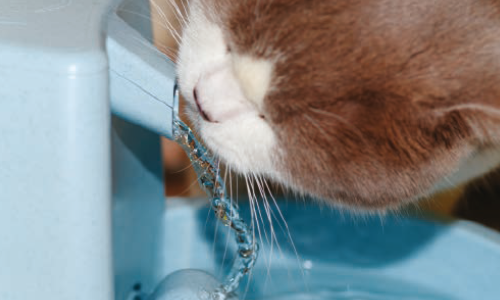Practice Scenario

Meet SOPHIE
A 5-year-old, spayed-female, mixed-breed cat
- Sophie is in hospital today for a routine wellness examination. Her body condition score is 5/9, which is consistent with previous visits.
- Although Sophie has always been healthy, her owner is concerned about Sophie’s risk for lower urinary tract disease.
- Sophie is an indoor-only cat that eats mostly dry cat food, although she receives occasional treats of canned food.
Hydration
Hydration in Pets
Water is a vital nutrient. Fresh, clean water should be provided at all times to pets. Healthy pets will typically adjust their water intake to meet their needs. Although adequate hydration is always important, there are times when extra consideration should be paid to a pet’s hydration status and/or when increased water consumption is encouraged.

Key Messages
- To monitor a pet’s hydration status at home, the owner can use:
- Skin tent test – after gently pinching and releasing a fold of the pet’s skin, the skin should immediately return (“snap back”) to its original position.
- Gum color and feel – after briefly pressing a finger against the gums, the gum color at that spot will blanch (whiten) but should return to its original color within 2 seconds. The pet’s gums should also feel moist and warm.
- Pets are at increased risk of becoming dehydrated if they have an underlying health issue, such as GI upset (vomiting and diarrhea) or kidney disease, or when overheated. Senior pets might become dehydrated simply because they may be less inclined to drink. Very active dogs are also at risk and may need to be encouraged to drink.
- A recommendation to increase water intake is typically made for pets with urolithiasis and cats with idiopathic cystitis in order to increase urine volume and dilute the urine. Since increased water intake may also soften the stool, increased water intake also is recommended for cats prone to constipation.
- Methods to increase water intake in pets include:
- Feed wet food, which has a high moisture content.
- Feed dry food mixed with water to increase moisture content.
- To decrease resource competition in multi-pet households, offer multiple water bowls.
- Since cats may have individual preferences, offer cats various options for drinking, such as different bowls, still versus moving water, and cool versus cold water.
- Offer a nutrient-enriched, flavored water supplement.
To Share With Pet Owner:
Hydration in Pets
Water is vital to health. How much water should pets drink, are there differences between cats and dogs, and how can pets be encouraged to drink?
View Hot Topic
6 min to 10 min
